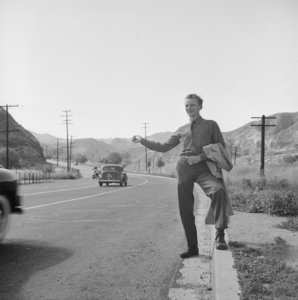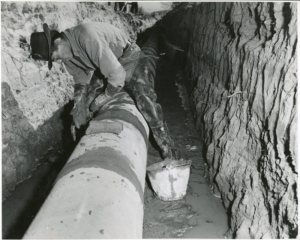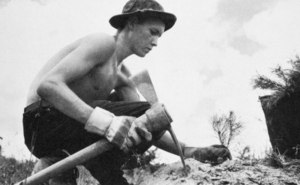
Hitchhiker
CCC recruit hitchhiking back to camp, San Fernando Valley, California, 1940.
Photo Credit: Rondal Patridge. Courtesy, National Archives.
In the spring of 1933, a newly inaugurated President Franklin Delano Roosevelt was facing a confluence of environmental and economic crises. The Ohio and Mississippi River basins were flooding. The Great Plains were choked with dust. More than a quarter of Americans were out of a job.
Roosevelt’s response to these colliding forces was to create a Civilian Conservation Corps that put young men (and only men) to work preserving soil, building trails and roads, and fighting fires. “In creating this Civilian Conservation Corps, we are killing two birds with one stone,” Roosevelt said during a fireside chat in May 1933. “We are clearly enhancing the value of our natural resources and, second, we are relieving an appreciable amount of actual distress.”
The American landscape we’re living in today is, in many ways, similar to the one Roosevelt inherited. The lockdowns imposed to stem the spread of COVID-19 have sparked the worst economic slump since the Great Depression. Heavy rains flooded the Midwest this spring, and an above-average hurricane season could do the same to the East Coast soon. Most of the West is in a historic drought, and large sections of the region are on fire.

CCC crew in New Mexico laying pipe to bring irrigation and drinking water to Santa Clara Pueblo lands, 1940. Courtesy, National Archives.
It’s against this backdrop that President Joe Biden has proposed revitalizing the New Deal–era program. A single sentence in Biden’s American Jobs Plan calls for mobilizing an army of workers to conserve nature and combat the climate crisis: “This $10 billion investment will put a new, diverse generation of Americans to work conserving our public lands and waters, bolstering community resilience, and advancing environmental justice through a new Civilian Climate Corps, all while placing good-paying union jobs within reach for more Americans.”
Now, some legislators are trying to make that vision a reality. Senator Ed Markey of Massachusetts and Representative Alexandria Ocasio-Cortez of New York, both Democrats, introduced a new bill that fills in some of the details of Biden’s ambitious idea. Dubbed the Civilian Climate Corps for Jobs and Justice Act, it would put 1.5 million Americans to work building climate-resilient infrastructure, reducing carbon emissions through renewable energy and conservation projects and helping communities recover from climate disasters. It would grant corps members many of the provisions on Democrats’ “social infrastructure” wish list, including a $15 an hour salary, full health care and childcare services. Corps members would also receive training and education to help them transition into union jobs.

California Conservation Corps, 2021
The CCC Magalia 4 fire crew hikes to the fire line of the Dixie Fire in Plumas County, California. Courtesy, California CCC.
“It is now this generation’s turn to answer the call and meet the historic challenges of our time,” says Markey. “We don’t have time for incrementalism. We don’t have time for Herbert Hoover–type complacency. This moment demands big, bold, progressive change. This is our FDR moment.”
Much of the environmental community has hailed the idea. Michael Brune, Sierra Club’s executive director, called it “a once-in-a-generation opportunity to create good jobs for every young person who wants one and to help ensure their safety in a climate-changed world.”
A modern Civilian Climate Corps like the one Biden, Markey, and Alexandria Ocasio-Cortez are proposing also has wide bipartisan support among voters nationally. A recent survey of more than 1,200 likely voters found that 65 percent of respondents support the idea of a Civilian Climate Corps, with the highest support among young and rural voters. Half of those under the age of 45 said they would consider working in the corps.

Members of the Civilian Conservation Corps work to control the Malibu fire near Angeles National Forest, California, 1935. Public Domain.
There are a few notable differences between the original, Depression-era corps and the modern one proposed by Markey and AOC. The original corps only enrolled young men. Its camps were segregated. There was an entirely separate program for Native Americans, who often worked to develop their reservations for white tourists. By contrast, at least half the modern corps’ projects would take place in communities of color and rural and urban low-income communities. Half of the corps members recruited would be from those same communities. The modern corps would also respect tribal sovereignty and guarantee that at least 10 percent of its environmental justice funds went to tribal communities.
Reforestation and tree-planting is one area in which a new CCC could learn from the old CCC, which planted more than 3 billion trees. Biden has pledged to reduce US greenhouse gas emissions by more than 50 percent below 2005 levels by 2030.
Equipped with the latest findings from restoration ecology and forest management, the Climate Conservation Corps could make reforestation a pillar of its work.
Reducing greenhouse gas emissions is just one of the benefits. It might seem a bit rosy, but it’s possible that by connecting young Americans with each other across lines of race, class and geography, a revitalized CCC could (to steal Biden’s campaign slogan) help restore the soul of a divided nation.
